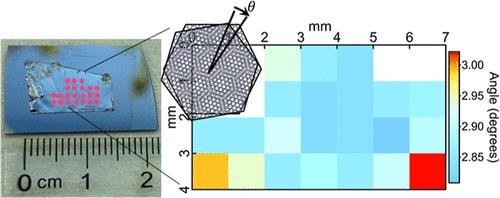具有可控角度的宏观均匀二维莫尔超晶格
IF 15.6
1区 化学
Q1 CHEMISTRY, MULTIDISCIPLINARY
引用次数: 0
摘要
通过范德华(vdW)层的精确堆叠设计的莫尔本文章由计算机程序翻译,如有差异,请以英文原文为准。

Macroscopic Uniform 2D Moiré Superlattices with Controllable Angles
Moiré superlattices, engineered through precise stacking of van der Waals (vdW) layers, hold immense promise for exploring strongly correlated and topological phenomena. However, these applications have been held back by the common preparation method: tear-and-stack of Scotch tape exfoliated monolayers, which suffer from low efficiency and reproducibility, twist angle inhomogeneity, interfacial contamination, and micrometer sizes. Here, we report an effective strategy to construct highly consistent mixed-dimensional and twisted bilayer vdW moiré structures with high production throughput, near-unity yield, pristine interfaces, precisely controlled twist angles, and macroscopic scale (up to centimeters) with enhanced thermal stability. We demonstrate the versatility across various vdW materials, including transition metal dichalcogenides, graphene, and hBN. The expansive size and high quality of moiré structures enable reciprocal-space high-resolution mapping of the superlattices and back-folded moiré mini band structures with low energy electron diffraction (LEED) and angle-resolved photoemission spectroscopy (ARPES). In particular, we identify the backfolded bands at the K point of twisted transition metal dichalcogenide moiré structures. This technique will have broad applications in both fundamental studies and the mass production of twistronic devices.
求助全文
通过发布文献求助,成功后即可免费获取论文全文。
去求助
来源期刊
CiteScore
24.40
自引率
6.00%
发文量
2398
审稿时长
1.6 months
期刊介绍:
The flagship journal of the American Chemical Society, known as the Journal of the American Chemical Society (JACS), has been a prestigious publication since its establishment in 1879. It holds a preeminent position in the field of chemistry and related interdisciplinary sciences. JACS is committed to disseminating cutting-edge research papers, covering a wide range of topics, and encompasses approximately 19,000 pages of Articles, Communications, and Perspectives annually. With a weekly publication frequency, JACS plays a vital role in advancing the field of chemistry by providing essential research.

 求助内容:
求助内容: 应助结果提醒方式:
应助结果提醒方式:


